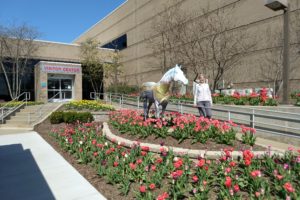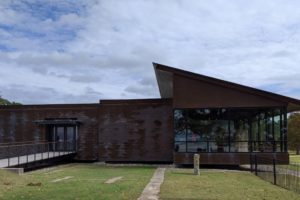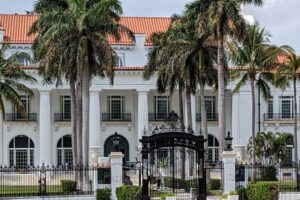At the time of the BIG guns being built around the turn of the 19th century, Fort Morgan was so much more than the fortress of the Civil War era that we spent time learning about and that we’ve toured. After looking at the batteries that supported the BIG guns in the previous post, now we’ll look at some of the other buildings of that time period and the last battery that was built here.

The buildings we’ll be looking at in this post are all east of the fortress. Some are close to the Gulf Coast and others close to Mobile Bay.
peace magazine
When Fort Morgan was modified around the turn of the 19th century, a $7000 allocation had been made to build a Peace Magazine that would serve as the central storage area for storing powder for the fort’s guns. If war was expected, the powder could be moved to each gun battery’s magazines that were better protected.

The building remained largely intact until Hurricane Frederic in 1979 tore the roof from the building and collapsed the upper brick work.


Battery Dearborn

The battery mounted eight 12-inch breech-loading mortars that weighed 13 tons each and were 11’9″ long. Instead of firing directly at a target, these mortars were hit into a “zone.” Different weights of projectiles and powder charges were used in each of the 8 zones. These projectiles weighed between 824 and 1046 pounds and were propelled by powder charges weighing 54-64 pounds. Maximum range for each mortar was 7 miles.

During field exercises, the Coast Artillery Companies would pitch their tents at the rear of their respective batteries. The wood structure on top of the battery protected the range-finding scopes that tracked targets.

In May 1918, the Army took 2 of the mortars from each pit to ship over to France for the American Forces to use during WWI. While the battery was deactivated in 1924, four mortars stayed here until 1942 when they were scrapped for the WWII war effort




post bakery


The Quartermaster Department issued their first standardized plan for a bakery in 1872. Their plan was for a 1-story rectangular building with ovens and a store room along a wall. The rest of the interior was to be left open.

right: the rebuilt bakery after the hurricane was almost twice as large
By the end of the 1800s, bakeries were standard fixtures on Army posts. Their size increased to meet the needs of larger garrisons
Between 1891 and 1906, the Quartermaster Department changed their plans for bakeries to include such rooms as a bedroom for the cooks, boiler room, lavatory, and specialized rooms for preparing bread, fuel, and proofing (also called proving, a step in the preparation of yeast bread and other baked goods where the dough is allowed to rest and rise a final time before baking. During this rest period, yeast ferments the dough and produces gases, thereby leavening the dough.) Again, thanks Wikipedia for the information.
The 1906 hurricane destroyed the original bakery. The building today was built after 1910 for the Coast Artillery Corps units stationed here from 1911-1921.

bottom: The bakery in 1917; the front porch was enclosed to create 2 additional rooms.
officers’ row


The stratified society of this time period found its way into military life so that separate and distinct areas for the various classes of individuals were developed. Officers and their families had all possible modern conveniences, including electricity. They were quartered in 10 large houses facing Mobile Bay and had access to their own tennis court and an officer’s only bathing area on the beach. The western end of Officer’s Row closest to the fortress was anchored by the Post Administration Building and the Guard House, giving the officers the shortest walk possible to the center of post activity.


Of the original structures, only 3 remain, and none were open for us to visit. The Post Administration Building was built in 1898, the kitchen section of a Company Officer’s Quarters was built in 1910, and a Single Set Officer’s Quarters was built in 1902. The rest of the structures have been lost through gradual decline, fire, demolition, and hurricanes after the fort was closed in 1944.


We’re finally done with Mobile Point Fort Morgan as we’ve covered 250 years of life that took place here by the military personnel representing France, Spain, Britain, and the U.S.. We’ve seen defensive structures evolve as they’ve had to keep up with technology. I don’t know about you, but I’ve learned so much about the Civil War and military defenses from our day trip to Fort Morgan in southern Alabama.




